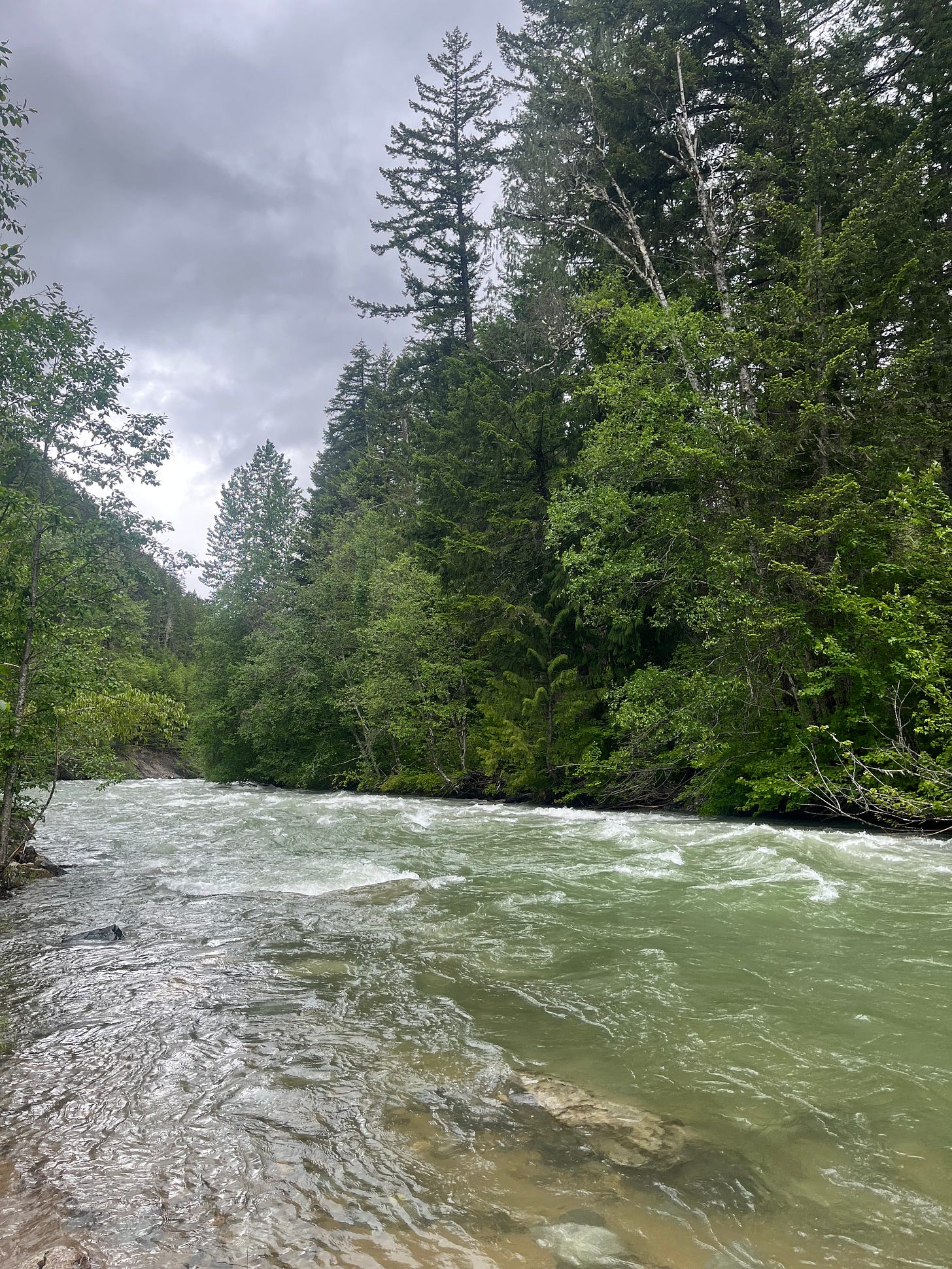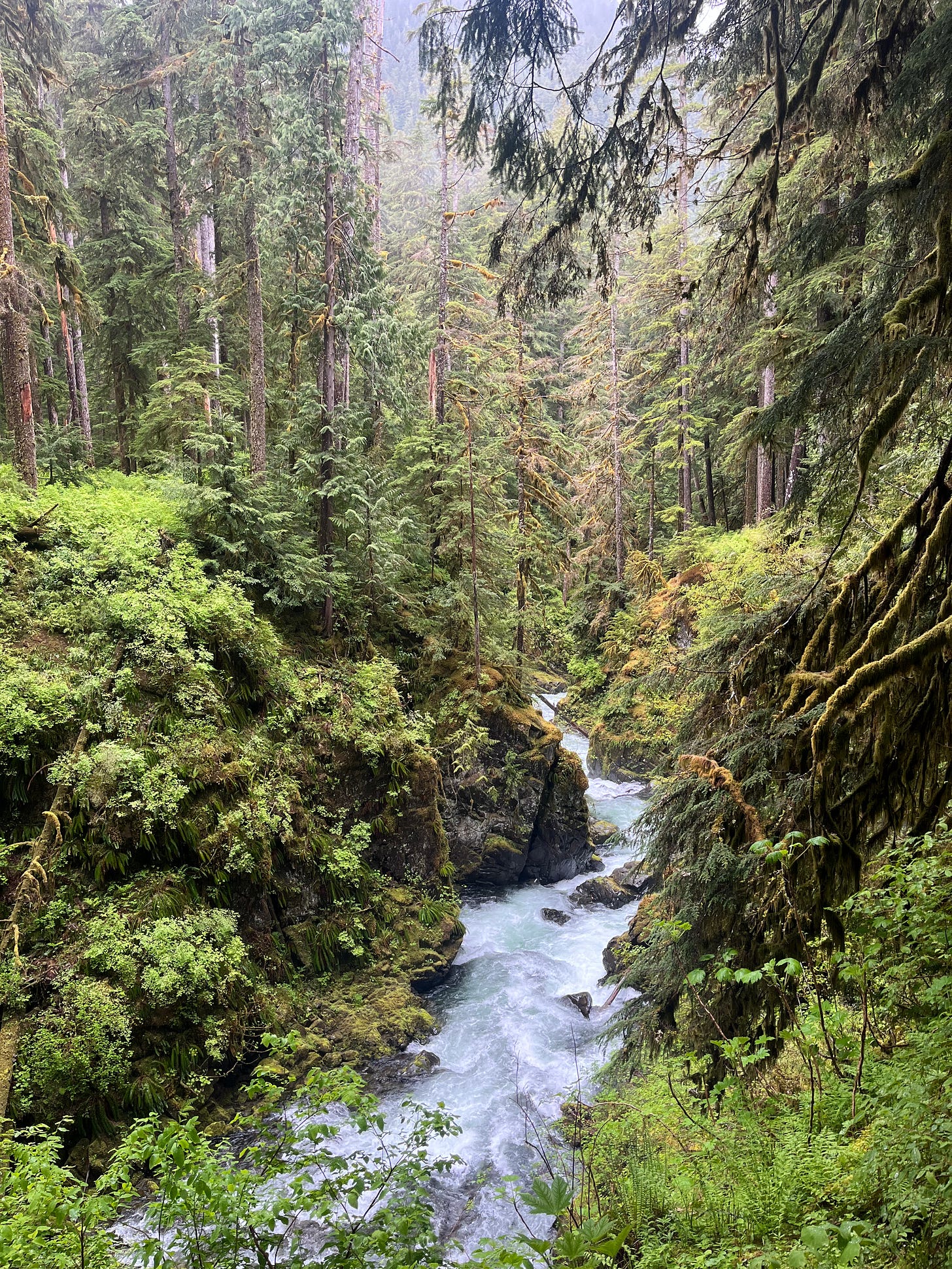The unsolved problem? Water
Prime Future 105: the newsletter for innovators in livestock, meat, and dairy
I recently spent several days in Washington and when I go to the mountains, I document water like it's my job, y’all.
I make no apologies for my water obsession though. I live in the desert so it is never lost on me how water is synonymous with life. Water represents potential and opportunity for growth and flourishing...humans, plants, animals.
We all know water is a precious resource. And we know we need reliable access to water to raise livestock and produce meat, from growing feed to watering animals to water usage in processing.
So why aren’t we urgently talking about water solutions for both the short and long term? Today we're starting a conversation on water by framing up a few key aspects of The Water Issue.
Let caveat this entire discussion: (1) water is a wickedly complex topic, (2) the challenges are often hyper-local and vary whether you're talking about surface water or ground water among other variables, and (3) the debates are intense.
The magnitude of The Water Issue
Meatingplace did a solid series on meat packers’ efforts to improve water efficiency, and framed the magnitude of the broader water situation this way:
"As is, the average American uses 80 to 100 gallons of water per day, in a nation using an estimated 345 billion gallons every day. That same nation is expected to be home to 200 million more people in the next 70 years, for a total population of nearly 514 million. And they’re moving more and more to the hot and dry South and West, according to new census data published in April. Those regions now account for nearly 63% of the total U.S. population, compared with just under 50% in 1970.
The country saw a nine-fold increase of total withdrawals over the first 80 years of the 20th century, thanks to supply-side adaptations like the construction of reservoirs, canals and pipelines. The rate of construction of such conveyances, however, peaked in the 60s."
Oof.
The crux of the issue for water is getting the right amount of water to the right place at the right time, at a reasonable price.
Add an -ish to each of the parts of that equation because that’s how nature rolls.
I also like how Meatingplace framed this as a two sided problem:
"The collective conservation effort will continue on two fronts:
enhancing water supply and/or reducing water demand.The former entails supply-side efforts from enlarging reservoirs, to linking supplies via new canals, to reusing regenerated wastewater, to desalinating brackish and seawater. The latter demand-side approach enlists new water-saving technologies and laws that limit withdrawals from stressed sources such as at-risk aquifers."
So let's say there are two sides of the water issue:
Ensure water supply
Reduce water demand
My hypothesis is that the first is more of a collaboration problem; the second is more of a technology problem.
Let's start with definitions. What are ways to increase water supply? It's things like...
Building reservoirs or increasing capacity to store water
Building canals and pumping systems to move water
Building water districts to treat water as a utility like electricity
While on my mountain adventures I read a biography on WD Farr, Cowboy in the Boardroom. WD is best known as one of the first people to reject the dogma of his time that cattle must be finished where the feed is located by bringing the cattle to the feed. He made the bold decision to build a feedyard in eastern Colorado and bring the feed to the cattle. As interesting as his influence on the future of cattle feeding was, it was his work to establish systems of water transportation, storage, and distribution to the semi-arid region of northern Colorado that I found most fascinating.
Why? It was a function of two things:
1. His belief that northern Colorado would attract people and become a populous area in the future.
2. WD grew up in the Great Depression and more importantly, the drought that caused the Dust Bowl of the 1930's. He knew firsthand how drought could sneak in and destroy farms, communities, even entire regions. So his goal became to secure permanent water availability for the region.
Pretty prescient, eh?
Farr’s biography details the multiple major water projects in the mid 19th century that WD helped broker among stakeholders with competing interests and visions including politicians, environmental groups, large & small municipalities, large & small farmers, and many others who struggled to see eye to eye. No they didn't have Facebook but yes they had plenty of whacko conspiracy theorists trying to jam up projects. But they made stuff happen anyway.
Reading about the creation of those major water projects is like reading a relic of another time completely. Have any states in the western United States done major water storage/transport projects in the last 20 years? 50 years?
Could a major water project even be agreed upon, let alone permitted, in the polarization of the public square today? It's hard to imagine, isn't it?
And yet, with the combination of growing population (aka increased residential water demand) and severe drought in much of the west, the water issue is getting to code red levels of criticality in some geographies.
Take California where Central Valley farmers are grappling with new restrictions on groundwater usage at the same time as surface water availability is more limited than ever.
Or Arizona, now 'celebrating' 2+ consecutive decades in a drought, where 36% of water for both agricultural and residential use is from the Colorado River. But as the river gets lower, the largest reservoirs are now at record lows, and new restrictions on water usage are completely changing the game for irrigated acres that are reliant on surface water. (Here's a good article.)
Even if it started raining tomorrow Noah’s ark style and the Western US were entirely out of a drought, there's still the fact that the region is drought prone and that more people are residing in these areas than ever before, growing the annual water requirements in addition to water demand for agricultural use. So we should probably do something to prepare for the next severe drought, wouldn’t ya say?
But maybe it seems California and Arizona are two extreme examples and they aren't representative of all regions in the US let alone the world. I'll buy that. So let's zoom out and consider a few broad hard-to-argue assumptions about the future, across most regions and climates:
Population will continue to grow creating increased need for residential water.
Battles between residential water use and agricultural water use will continue to be an issue.
Battles will continue between environmentalists and industry.
#1-3 will mean that water will be increasingly regulated at all levels of government.
Maybe the first innovations we need are an increase in common sense collaboration. But hope isn't a strategy. So what's the play here?
The limiting factors for increasing water supply aren't really problems technology can solve (yet), they are people problems...where humans need to organize around a shared vision. Which is really really really hard to do.
(Though interestingly WD did experiment with cloud seeding in the 1950's as a potential tech solution for increasing rainfall but it was met with a lot of resistance and didn't prove very fruitful anyway.)
One minor point - in a water constrained environment, can we assume that lawns are a luxury not a necessity? Isn't it likely that in 50 years we look back at the quaint time when a patch of grass was default standard issue with American homes? I think so.
Back to livestock. Meatingplace referenced this summary of water usage in Tyson operations and in Tyson’s supply chain:
"The meat industry’s largest corn buyer, Tyson, says irrigated corn feed accounts for 91% of its supply chain water consumption, as opposed to 7% for raising animals and 2% for plant operations (31B gallons in FY 2019)."
Those numbers aren’t surprising, but they do tell a story. Next week we'll dig into the implications and look at the demand side & reducing water needs across feed, livestock, and meat processing.
Technology isn't the answer to everything but in a world where it's politically difficult to solve water from the supply side, the burden gets shifted to the demand side to reduce the need for water for residential and agricultural use.
I expect we will see more water focused innovation in agriculture in the next decade because we have to.
Cathie Wood is a well known tech enthusiast and fund manager, who wrote this tweet referring to the economic problems at the moment. But I think we can put water in the bucket of super-pressing-and-urgently-critical problems. And the principle still applies: innovation solves problems.
What a time to be alive 😉







